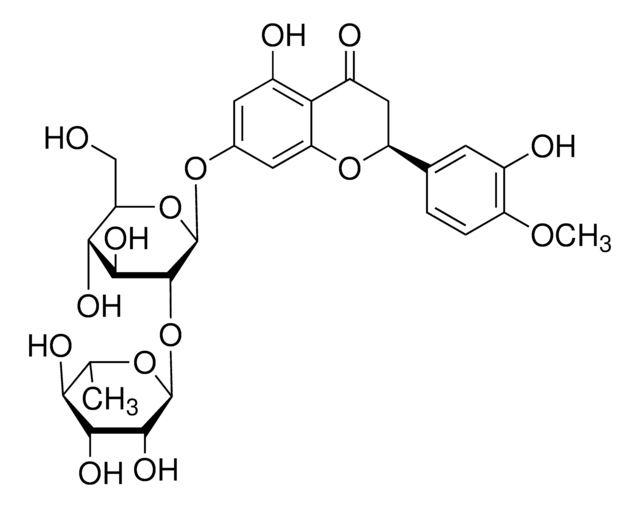Wichtige Dokumente
L9647
Limonin
from citrus seeds, >90% (HPLC)
Synonym(e):
Citrolimonin, Dictamnolakton, Evodin, Obaculakton
Größe auswählen
Größe auswählen
About This Item
Empfohlene Produkte
Biologische Quelle
citrus seeds
Qualitätsniveau
Assay
>90% (HPLC)
Form
powder
Anwendung(en)
metabolomics
vitamins, nutraceuticals, and natural products
Lagertemp.
2-8°C
SMILES String
CC1(C)O[C@H]2CC(=O)OC[C@]23[C@H]4CC[C@@]5(C)[C@@H](OC(=O)[C@H]6O[C@@]56[C@]4(C)C(=O)C[C@@H]13)c7ccoc7
InChI
1S/C26H30O8/c1-22(2)15-9-16(27)24(4)14(25(15)12-31-18(28)10-17(25)33-22)5-7-23(3)19(13-6-8-30-11-13)32-21(29)20-26(23,24)34-20/h6,8,11,14-15,17,19-20H,5,7,9-10,12H2,1-4H3/t14-,15-,17-,19-,20+,23-,24-,25+,26+/m0/s1
InChIKey
KBDSLGBFQAGHBE-MSGMIQHVSA-N
Suchen Sie nach ähnlichen Produkten? Aufrufen Leitfaden zum Produktvergleich
Verwandte Kategorien
Allgemeine Beschreibung
Anwendung
- to treat human peripheral blood mononuclear cells (PBMCs) to test its effect on human immunodeficiency virus (HIV) replication[3]
- to test its effects as an anti-osteoporosis agent in osteoblastogenesis activity in MC3T3-E1 cells and ovariectomized (OVX) rat model[4]
- as a reference standard in high-performance liquid chromatography (HPLC) system[5]
Biochem./physiol. Wirkung
Lagerklassenschlüssel
11 - Combustible Solids
WGK
WGK 3
Flammpunkt (°F)
Not applicable
Flammpunkt (°C)
Not applicable
Hier finden Sie alle aktuellen Versionen:
Analysenzertifikate (COA)
Die passende Version wird nicht angezeigt?
Wenn Sie eine bestimmte Version benötigen, können Sie anhand der Lot- oder Chargennummer nach einem spezifischen Zertifikat suchen.
Besitzen Sie dieses Produkt bereits?
In der Dokumentenbibliothek finden Sie die Dokumentation zu den Produkten, die Sie kürzlich erworben haben.
Aktive Filter
Unser Team von Wissenschaftlern verfügt über Erfahrung in allen Forschungsbereichen einschließlich Life Science, Materialwissenschaften, chemischer Synthese, Chromatographie, Analytik und vielen mehr..
Setzen Sie sich mit dem technischen Dienst in Verbindung.



